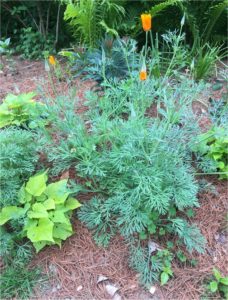Garden Mulching 101
At Berkshire Botanical Garden, pine needles or “pine straw” is an attractive natural mulch for plants that prefer acidic soils.
By Thomas Christopher
I’m in favor of anything that makes my work in the garden easier, which is why, in most regards, I am a fan of tucking in my plantings with a couple of inches of some organic mulch. In the ornamental garden, I most often use shredded leaves, because this is not only effective but also, throughout this part of the country, free for the taking in the autumn. In the vegetable garden, I most often use straw. This is effective and seems less likely to harbor slugs and snails than the leaf litter.
Both have similar benefits. By covering weed seeds and keeping them in the dark, a cover of mulch 2 to 4 inches deep helps to prevent them from germinating, reducing the need for weeding. What’s more, when weeds do grow up through a layer of mulch they tend to be shallow rooted and easier to pull. Mulch insulates the soil, keeping it cooler in the summertime and warmer in the winter, both conditions that are better for root growth. Mulch also inhibits the evaporation of moisture from the soil surface, which can reduce the need for summertime irrigation by as much as 50 percent. Finally, as an organic mulch decomposes, it contributes organic matter to the soil, helping to build humus.
Given all the benefits that an organic mulch can provide, it sounds ungrateful in the extreme to point out that there are some problems can arise from mulching, but that is the case. To begin with, if you use bagged mulches such as cocoa hulls or bark nuggets, covering a substantial area can be expensive. Materials that can be purchased in bulk, such as shredded bark, are much more economical, but this can encourage overly lavish use.
The most egregious form of this is what is often called “volcano mulching.” This describes the bad practice of heaping mulch up around trees, burying the base of the trunk several inches deep. This can lead to decay of the trees’ bark underneath and inside the mulch, leading to the decline and eventual death of the affected trees. A quicker death may occur if the mulch is relatively fresh; when moistened by rain or irrigation, it may start to decompose rapidly, heating up and cooking the trees’ bark and the layer of growth, the cambium, inside.
Another form of overuse often occurs when the mulch becomes so prevalent it is a major feature of the landscape. The color of organic mulches, especially that of shredded bark, tend to fade as they age, gradually turning an unattractive gray. The common response is to dress up the landscape periodically with an additional layer of fresh mulch. This can result in an unhealthy build-up, a thick, matted layer that keeps the soil below too wet and prevents oxygen from reaching the plant roots.
An additional issue with carbon-rich mulches such as bark or wood chips is that they temporarily withdraw nitrogen from the soil as they decompose. This has led to widespread warnings that use of these mulches must be accompanied with a corresponding boost in fertilization, specifically, the application of fertilizers rich in nitrates. This seems to be mistaken, at least in the case of deep-rooted plants such as trees and shrubs. That’s because the nitrogen-depleting effect of the mulches is confined to the interface of the mulch and soil, in other words, the surface soil. Trees and shrubs with established root systems will be unaffected by what is at any rate only a short-term loss – the nitrogen that the mulches do absorb will be released eventually as decomposition is completed.
Such mulches, however, may be problematic for frequently renewed, shallow-rooted plantings such as annual and perennial flowers. For displays of those sorts, I recommend using last autumn’s leaves. If chopped with a mower or shredder at the time when they were collected and then left to weather in some inconspicuous spot, they will be semi-decomposed and the perfect mulch to sift in among your flowers. At Berkshire Botanical Garden, pine needles, or “pine straw” is used around plants that prefer acidic soils. This freely available, lightweight mulch will break down relatively slowly compared to other organic mulches, is natural looking, and tends to stay in place during heavy rain events.
Thomas Christopher is the co-author of “Garden Revolution” (Timber Press, 2016) and is a volunteer at Berkshire Botanical Garden. berkshirebotanical.org
Be-a-Better-Gardener is a community service of Berkshire Botanical Garden, one of the nation’s oldest botanical gardens in Stockbridge, MA. Its mission to provide knowledge of gardening and the environment through 25 display gardens and a diverse range of classes informs and inspires thousands of students and visitors on horticultural topics every year. Thomas Christopher is the co-author of Garden Revolution (Timber press, 2016) and is a volunteer at Berkshire Botanical Garden. berkshirebotanical.org.




